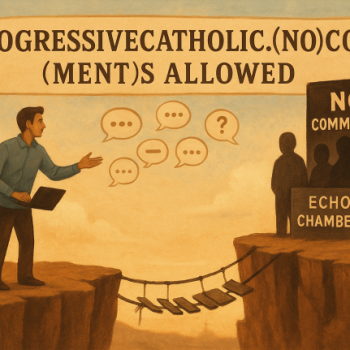GODSTUFF:
BLASPHEMY LIKE PORNOGRAPHY: YOU KNOW IT WHEN YOU SEE IT
It would seem that, much like beauty, perfection and the difference between Ashley and Mary-Kate Olsen, blasphemy, at least these days, is in the eye of the beholder.
We don’t really talk much about blasphemy, or its cousin, sacrilege, anymore. It kind of sneaks up on us and catches us by surprise when we’re not looking.
Such was the case with cartoons depicting the Prophet Muhammad (peace be upon him) in a Danish newspaper.
Apart from our Muslim brothers and sisters and the odd Dane among us, most of us hadn’t given much thought to the prophet or Denmark.
That is until last month, when all hell broke loose over cartoons that the obscure Scandinavian newspaper editors say they thought were harmless socio-political commentary, and scores of Muslims thought were an affront to God of the first order.
In an age of pluralism, multiculturalism, and (some say) secularism, what constitutes blasphemy?
Is it an image of the Buddha adorning a flip-flop?
A Hindu deity on the front of a skimpy tank top?
Madonna and Guy Ritchie praying at the tomb of the Matriarch Rachel in Israel?
Jesus as a namby-pamby cable-access talk-show host on “South Park”? Or political paraphernalia that says it’s our “God-given right” to bear arms?
Is nothing sacred anymore?
Technically, blasphemy refers to something that is said and sacrilege means something that is done, as in the desecration of a sacred space or throwing a consecrated communion wafer on the ground.
In practice, they’re a little harder to nail down than they were even a few generations ago.
“Historically, blasphemy has always been identified with criticizing, denigrating, or marginalizing the sacred, and in Jewish and Christian tradition it’s connected with profaning the name of God, or persons such as Jesus or the Holy Spirit, or even teaching connected with the God of the Bible,” Bob Hodgson, dean of the Nida Institute for Biblical Scholarships at the American Bible Society in New York City, told me. “It’s the kind of categorical expression for vast disrespect of the most sacred and holy things in our faith.”
Nowadays, as every religious tradition wrestles with what it means to engage popular culture, it feels sometimes like anything goes. But it doesn’t.
The problem, Hodgson says, is when something that is sacred, which means that it is supposed to be separate or set-aside from everything else, is placed in a context where it doesn’t normally belong.
Like Lord Buddha on a flip-flop.
“When they’re put back into popular culture and the media in ways that don’t seem consistent with their sacredness, their holiness, that’s where blasphemy occurs,” Hodgson said. “The test of blasphemy is often not whether we as the consumers feel a T-shirt of an icon or a statue is misplaced or misused. The real test is what do members of that community of faith think?”
That last part got me thinking about the brave (or foolish) folks who make their living in that oddest of publishing niches: religious satire.
The granddaddy of them all is The Wittenburg Door, a colorful, irreverent more-or-less bi-monthly magazine that has poked fun at the pomposity of some Christians and Christian institutions since 1971.
Where does The Door, as it is affectionately known, draw the line between humor and blasphemy?
“As you might imagine, we’ve struggled with this issue for the past 30 (very) odd years and have been accused of blasphemy repeatedly, sometimes actually by people who can spell it correctly,” said Robert Darden, editor in chief of The Wittenburg Door.
“When self-appointed prophets speak about faith and live lavishly beyond the dreams of the Borgias. Those are the kinds of things that we see provoking the Holy Spirit to righteous anger,” Darden said. “That said, we’re still careful. We don’t do ‘Christ on the Cross’ jokes. We don’t make fun of the Holy Spirit. We don’t show a vengeful, vindictive God who respects only the rich and powerful. Nor do we lampoon the deities of other religions. However, the people who make themselves rich in the name of God or Allah are fair game, as are the people who pretend to speak for Krishna or Y*HW*H — usually to their own advantage. YOU may say that God said, ‘touch not the apple of mine eye’ — but until God sends us the memo, you’re fair game, bud.”
Joshua Neuman, the 34-year-old editor of Heeb: The New Jew Review, an edgy quarterly that dares to go where few others go and with a truck-load of chutzpah — the fall 2005 issue about sexuality ran with a racy picture of comedienne Sarah Silverman and a headline that read, “Holy Sheet! It’s the Sex Issue” — doesn’t think his magazine steps over the line.
Heeb got in some hot water a few years back when it ran an article spoofing Mel Gibson’s “The Passion of the Christ,” that in one place depicted a topless Virgin Mary.
“My response is generally that blasphemy is trotting out religion in defense of sexism, racism and homophobia, not cartoons of boobies,” Neuman said.
In the sex issue there is a 12-page spread of sexually explicit illustrations accompanying famous passages from the Hebrew scriptures. The editors called it, “In a Biblical Sense: Dirty Pictures from the Holy Scriptures.”
Not for the faint of heart. Even I blushed.
“Heeb‘s always been about blurring the line between those two worlds — the secular and the religious,” Neuman said. “We’re asking questions about what really should be considered sacred and what really should be considered profane.”
A couple of Canadian guys way up in Winnipeg, Manitoba, think they know, and they’ve started a new Christian magazine to test their theories.
Founder/publisher Aiden Enns and editor Will Braun published their first issue of Geez, described as “holy mischief in an age of fast faith,” last fall.
The first blasphemy complaints rolled in almost immediately.
“Some were complaining about the name Geez, especially older folks who think it’s taking the Lord’s name in vain,” said Enns, 44, who left the anti-advertising magazine AdBusters in 2003 to start Geez. “I’ve said, ‘It’s almost taking the Lord’s name in vain. It’s intended to promote a discussion so we can talk about what blasphemy really is.”
Enns and Braun, who were raised in the conservative Mennonite tradition, take their Christian faith very seriously, and cannot abide what they deem the real blasphemy, “things that the church turns a blind eye to which we think is sacrilege,” Enns said.
Like ignoring the needs of the poor, the environment, rationalizing war-making with religion, and turning Holy Scripture into a commodity.
Like Rupert Murdoch, for instance. The media mogul’s News Corp. owns publishing behemoth HarperMorrow, which owns Zondervan, which publishes more Bibles than anyone else in the world, Enns points out.
“When the owner of one of the world’s biggest media corporations buys up one of the leading Bible publishers and uses it to fuel his for-profit engine . . . we consider that blasphemous,” he said.
A while back, Enns took a razor to the spine of his Zondervan-produced Bible and cut the word “Zondervan” off, covering the hole with a piece of duct tape.
Some people might consider that a sacrilege.
“I circumcised it,” Enns said.
Copyright © The Sun-Times Company
All rights reserved. This material may not be published, broadcast, rewritten, or redistributed.















